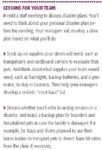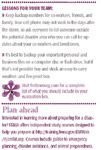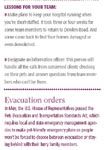What Hurricane Rita taught us
Drive down the dead-end road to Donna Rivers' house and you might get the feeling Hurricane Rita happened yesterday, not nearly a year ago.
Drive down the dead-end road to Donna Rivers' house and you might get the feeling Hurricane Rita happened yesterday, not nearly a year ago. Along the one-mile stretch you'll see the remains of downed trees and other debris that FEMA hasn't yet collected. Many home repairs stay undone and fences still lay scattered; contractors have been too busy to tackle many of these residential repairs.
Despite the Category 5 storm with winds that reached up to 180 miles an hour and caused about $10 billion in damages, one veterinary practice in Beaumont, Texas—the one where Rivers works—managed to stay open throughout the hurricane that devastated parts of the Gulf Coast. But surviving the storm that brought down trees, signs, and fences and destroyed homes and businesses was only the first step toward recovery for Dowlen Road Veterinary Center. Is your practice prepared for a disaster? Consider this practice team's experience and use these tips to prepare for the worst.

When Donna Rivers returned home after Hurricane Rita struck, she found trees blocking her driveway. "You had to have four-wheel drive to get through," Rivers says. "We had to park our car a mile out from the house and walk."
Before the storm
The days before the hurricane were busy ones for the team at Dowlen Road Veterinary Center. On the Sunday night nearly a week before the storm, Rivers, Dowlen Road's practice manager, received a phone call that her mother had suffered a stroke and was in a Springfield, Mo., hospital. On Monday afternoon, she drove to Missouri. At the practice's weekly staff meeting, practice owner Kelley Kays, DVM, compiled a list of team members who planned to stay through the storm. Later, as the threats grew worse, many of these team members would follow the mandatory evacuation order and leave after all. But a core group of people promised to stay and care for boarded pets and handle any emergencies at Dowlen Road Veterinary Center and at Dr. Kays' second practice, Winnie Veterinary Clinic. Both hospitals would have one veterinarian on call as well as a veterinary assistant and a helper in the facility.

Lessons for your team
The mandatory evacuation order came on Thursday. That's when things started getting a little crazy, Dr. Kays says. Employees started to evacuate, and the clinic ran out of tranquilizers and cardboard pet carriers. Clients were dropping their pets off and the kennels quickly filled.
Dr. Kays made the decision not to turn any clients away; they would continue to take pets as long as they had floor space for the portable kennels clients brought their pets in. For safety, Dr. Kays required each boarded pet to be vaccinated. By the time the storm hit, Dowlen Road had 107 boarded animals, and Dr. Kays' second practice, Winnie Veterinary Clinic, had 35 pets.

Lessons for your team
Dr. Kays had lived through a hurricane before as a young veterinarian, so when she built Dowlen Road Veterinary Center she knew she wanted to safeguard her business. She chose high ground and used cinder blocks in her construction to ward off floods and high wind. "It's like Fort Knox," says Gayle Duhon, a veterinary assistant.
Dr. Kays also invested in a natural gas generator to keep the lights and air conditioning going if the power went out. "I had lived through a hurricane with no power, cleaning kennels in 100 degree heat, and at that point I decided that a generator would be a good thing," Dr. Kays says.
Weathering the storm
When the mandatory evacuation order came, Duhon knew she wasn't going anywhere. Dr. Kays offered to let her stay at the practice, and Duhon and her husband and grown son planned to have a hurricane party. After all, in their experience hurricanes often threatened, but Duhon had never experienced anything more than a lot of wind after 49 years in the area. She was convinced this one would be no different. So when the fire alarm woke her from a sound sleep at 3 a.m. on Sept. 24, 2005, she had no idea the storm was raging outside.

Dealing with personal loss
The well-insulated clinic blocked the sound, but as Duhon looked outside she could see the rain blowing sideways. This was the night most of the damage occurred. It was also the night Duhon's house was destroyed. (See "Dealing With Personal Loss")
The wind had started at 5 p.m. the night before. "We could hear the trees cracking and popping, so we came inside the clinic and watched TV," Duhon says. "At 3 a.m. the fire alarm went off, making a white light and an obnoxious sound."

Lessons for your team
The dogs were screaming; they felt the barometric pressure dropping. "We were awake for the rest of the night, and we watched the storm through a treated window," Duhon says. "The wind whipped around in circles, and things were flying."
In Missouri, Rivers sat in her hotel room watching news about the storm on TV. She tried to call her husband and daughter, but her call wouldn't go through. She had to hope they had evacuated. "As soon as the storm hit Beaumont, I started trying to head back," Rivers says. "I checked out of the hotel at 4 a.m. and started driving back. I was driving into the hurricane." On the road, she called her mother-in-law, who told Rivers that her husband and daughter had safety evacuated to his uncle's home in Lake of the Pines, outside of the hurricane's path.

Trees accounted for a lot of the damage from the storm. Dr. Kelley Kays says many of her clients returned home to scenes like this.
"As I was driving, trees were blowing into the road," Rivers says. She arrived at Lake of the Pines around 2 p.m. on Saturday. Downed trees kept her from reaching her family, so she waited out the rest of the storm in her car. "The winds were still really blowing," Rivers says. "Finally I reached my husband on the cell phone. He and his uncle came out and found me."
The days after
At night, the streets of Beaumont were black as pitch. Dogs ran loose, their bays a constant reminder of the chaos outside. By day, the city was a ghost town, the streets eerily quiet and empty. The police set up barricades to keep people from entering towns hit by the hurricane. These barricades also made it difficult for Duhon to check on her home, and Rivers and Dr. Kays had to talk their way past the guards to get to Dowlen Road Veterinary Center.
Even with a plan in place, the team hit some hitches. The natural gas generator Dr. Kays bought didn't keep the air conditioning working as she hoped. When the fire alarm went off the first night, it blocked the air conditioner from starting back up—a safety measure to help prevent fires from spreading. But there was no way to override the fire alarm, so the air conditioner never turned on. Team members battled the sweltering heat until power was restored 10 days later.

Lessons for your team
Duhon, her husband, and son began the first day after the storm the same way they would for the next several weeks—caring for the animals. One dog, keyed up from the storm, got loose. "I was trying to help the dog, and he bit me," Duhon says. This was only Duhon's first injury. With no air conditioning, the floors began to sweat, and Duhon slipped on a wet spot and broke her foot. "I bandaged it and wheeled around on an office chair," she says.
In the crippling heat, some of the older dogs and those with longer fur began to suffer. Duhon set up fans and sprayed them down with water to cool them off.
Sunday brought more pets. The storm tore fences and damaged houses, and many people who had stayed behind chose to evacuate, leaving their pets at Dowlen Road.
Road to recovery
On Tuesday, Rivers made it past the national guard to reach Dowlen Road Veterinary Center. She needed to do the payroll. And over the next few days Rivers would call team members who were now spread all across the country to check on them. She also recruited team members still in the area to come in and relieve Duhon for a few hours. Most team members wouldn't return to a full schedule for several more days or even weeks, but Duhon and Rivers worked tirelessly to handle the huge burden of animals they were caring for and manage each new crisis the aftermath of the hurricane brought.
"I spent a lot of time finding other employees and checking on them," Rivers says. "They all wanted to know about their homes and they asked whether they had electricity, so we tried to find that out for everyone."
The Texas Veterinary Medical Association delivered generators, dog and cat food, and barrels of gasoline to veterinarians in the area. "There was no fuel to be purchased for miles around," says Dr. Kays. "The barrels of fuel they delivered helped our employees get to work, and with the generators we were finally able to cool off and make the pets comfortable."

Ensure happy reunions
Dedication to service
Ten months after the storm, most team members have settled back into their normal lives. Duhon has a new home and the team is back to work, offering veterinary care to their old clients and the new ones they earned with their service through the storm.
Perhaps the most amazing part of this story is that all these dedicated team members agree they'll stay behind and care for animals again if hurricanes threaten. "These animals don't have anything but what we give them," says Duhon. "If we didn't take care of them, what would happen?" Dr. Kays agrees. "We just have the philosophy that we're here for people," she says.
Veterinary Heroes: Patricia Kennedy Arrington, DVM, CVFP
December 1st 2024As a leader in 24-hour veterinary care and a champion for women in the field, Patricia Kennedy Arrington, DVM, CVFP, has dedicated her 50-year career to transforming veterinary medicine and inspiring future practitioners.
Read More
Veterinary Heroes: Ann E. Hohenhaus, DVM, DACVIM (Oncology, SAIM)
December 1st 2024A trailblazer in small animal internal medicine, Ann E. Hohenhaus, DVM, DACVIM (Oncology, SAIM), has spent decades advancing the profession through clinical expertise, mentorship, and impactful communication.
Read More







